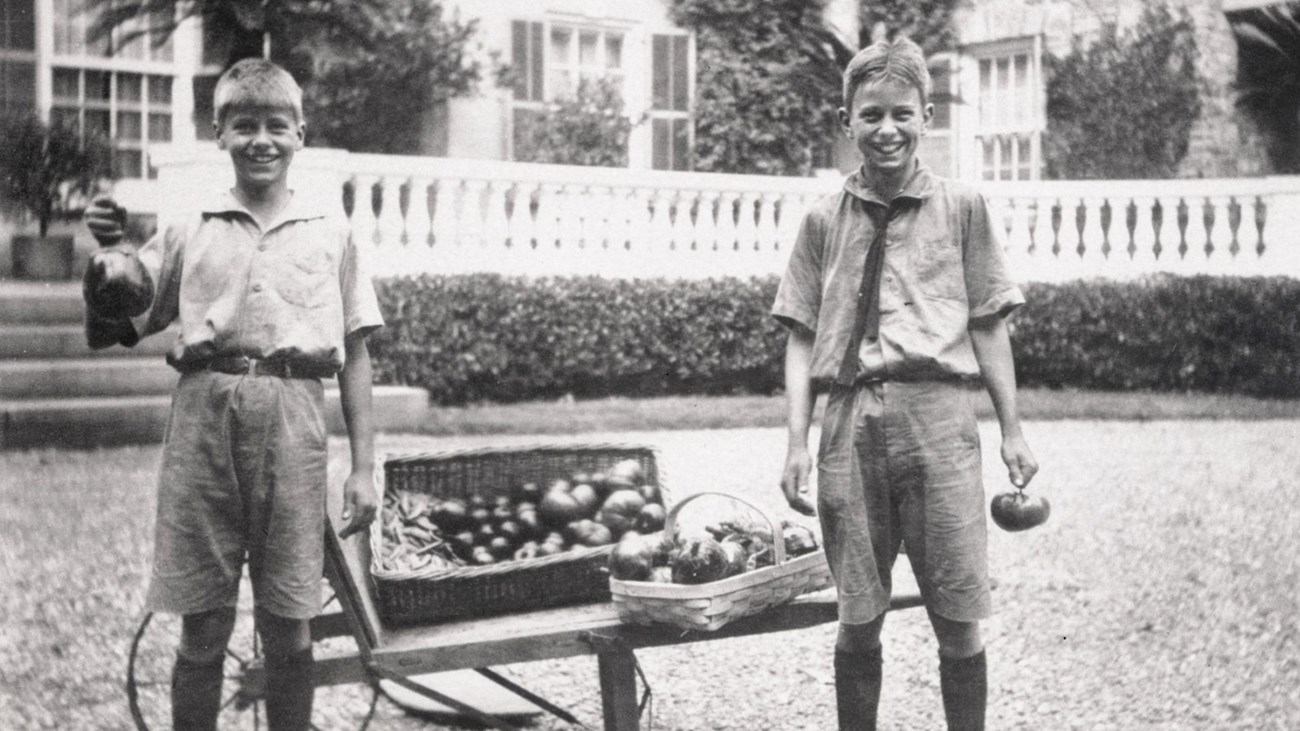
The Home Garden, nearly two acres in size, was a central part of life for the Roosevelt family. Franklin D. Roosevelt grew up working and playing in the garden, as did his children and grandchildren; this garden remained important to him long after his childhood. In his 1939 speech at the cornerstone laying for the presidential library, FDR reflected fondly on enjoying the sun-ripened harvest of the garden nearby. He recounted, “Half a century ago a small boy took delight in climbing an old tree, now unhappily gone, to pick and eat ripe Seckel pears. That was about 100 feet west to where I am standing now. And just to the north, he used to lie flat between the strawberry rows and eat sun-warmed strawberries—the best in the world.” FDR hoped that the American people would reflect on his presidential achievements in the context of his upbringing, and the Home Garden was clearly an important piece of that upbringing. Growing up in this garden shaped FDR’s ideals of sustainability, land stewardship, and his support of the grow-your-own movement in the 1940s. The Home Garden was not just an important piece of FDR’s childhood; it shaped the lives of his children and the legacy of his presidency. This garden and the rest of the Springwood estate were managed by FDR’s mother, Sara Roosevelt, and maintained by gardener William Plog. The produce in this garden fed the Roosevelt family and their staff. The Roosevelt farm was a prime example of gentleman farming in the Hudson River Valley. The farm did not aim to produce a profit, but rather to exemplify land husbandry to nearby residents. When the Roosevelts originally bought this property, the vegetable garden occupied a small bed in the present-day rose garden and gravesite. Although they were only a family of three, the garden expanded continuously throughout their time at Springwood, even after FDR’s departure for school and James Roosevelt’s death in 1900. The Home Garden was an integral part of Roosevelt family life. Frequently mentioned in letters between the Roosevelts, it was clearly important not only as a source of food, but as a part of their home—a part they made an effort to enjoy no matter where they were staying. When the Roosevelts weren’t living at Springwood, they would have produce shipped from their garden to wherever they were—to their property in Campobello, to New York, and to FDR at school in Massachusetts. 
In 1948, the Home Garden was replaced with a parking lot for both the National Historic Site and the Presidential Library. This lot improved public access to both sites—a pressing concern at the time—however, it did so at the cost of an important piece of Roosevelt history. It was not until 1975, when the park acquired the Bellefield property to the north of Springwood, that the park could begin to consider relocating visitor parking and reestablishing the original Home Garden. The National Park Service and the Presidential Library broke ground for a new Visitor Center in 2001, and demolition of the parking lot began in 2002. The restoration of the Home Garden was begin in 2016 as an official National Park Service centennial project with substantial support from the Franklin D. Roosevelt Hyde Park Foundation. Restoring the Home Garden remains an ongoing project as park horticulturists work to restore the soil structure and nutrients. The current vegetable garden is designed to replicate the Roosevelts’ garden with as much historic accuracy as possible. Minor adjustments are introduced to ensure its health and accessibility, including deer fencing around its perimeter and porous pavement paths. In addition, although the heirloom vegetable varieties grown in the garden today remain the same as during the Roosevelts’ time, they are cultivated using modern organic practices. Bug traps, black biodegradable film, white row cover, and kaolin clay are all examples of these modern strategies used to address common garden pests. The Home Garden is maintained through the support of volunteers who help plant, maintain, and harvest the crops. Produce is donated by the park's philanthropic partner, the Franklin D. Roosevelt Hyde Park Foundation, to Dutchess Outreach in the city of Poughkeepsie. In addition to being a food resource, this garden is used for a variety of educational programs, and is free and open for the public to enjoy. Visit our volunteer page for more information about how you can participate. This article was prepared by Meg Ritzau, Vassar College Community Engaged Learning Fellow. |
Last updated: August 31, 2021
